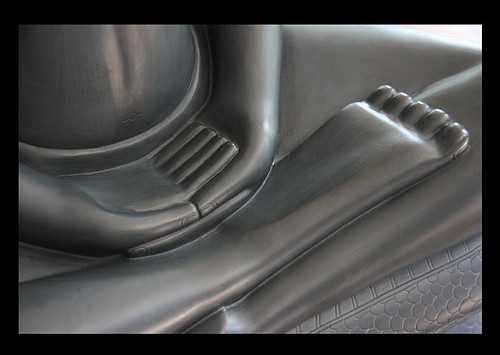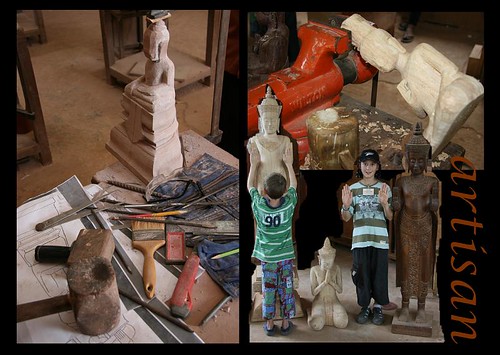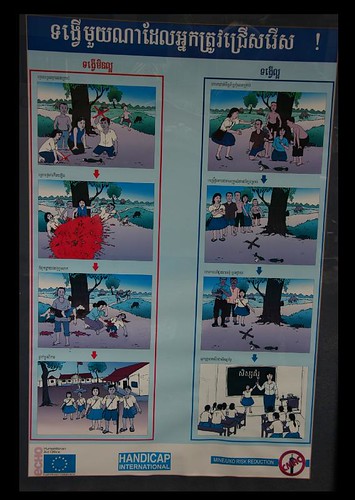unexpected cambodia contrast
by Rachael
Siem Reap, Cambodia
We had expected to cross the border and come face-to-face with poverty. Isn’t it Cambodia we always hear about in the news media? While there were beggars, small dirty children with even smaller babies hanging from their hips, there was also a large freshly-painted casino. And we were totally dazzled by the long avenue of five-star hotels, all decorated with strings of lights, on the drive in to Siem Reap. As we have moved around the city we have been surprised at the large buildings, new buildings – there is certainly evidence that the tourist dollar is pumping the economy…although not for the majority of the population. This morning we saw the other end of the spectrum, the discriminated-against-disabled. We visited a Disability Rehabilitation Centre, where over 80% of the clients have an income of less than a dollar a day. We also walked around the back streets away from the cafes, restaurants and hotels, and saw families living and working in shacks barely larger than a single bed.
Making the probably-inevitable comparison with Laos, it would seem that here there is dire poverty existing alongside immense wealth. There, what wealth we saw was far more modest. We did not see glitz, or *big*, or flashing lights or any sign of *professional* in Laos.
But we did see professional here in this tourist town. At an artisan training school, Artisans d’Angkor, we saw workshops where young people are apprenticed to learn the trades of silk-making and painting, statue-making and carving (all images taken from Angkor Wat)…..their standard of craftsmanship was high and the shop selling finished items was a large-scale upmarket boutique. Despite spending three weeks exploring the comparable tourist town of Luang Prabang, we didn’t experience anything as professional as this there. Unexpected contrast.



I had also expected Cambodia to be as “traditional” as Laos. But it appears more modern western. Instead of most women wearing a straight wrap skirt made from local cloth and hair to at least their waists, short haircuts and a variety of clothing styles are the norm, giving the streets here a far less conservative feel.
Ah yes, the streets. There’s another surprise. I had expected a mixture of sealed roads and hard dusty paths. But this city is one big beach! Actually, we are so far inland we are days away from any coast, but the soil is so sandy that wherever the pavement gives way, it is just like walking at the beach. The paths are not hard dirt, but soft sand. And along each roadside is a two-metre-wide “sandbank”. Unexpected.

Walking along one such street, we spied an array of self-made walking aids, crafted by people who had unknowingly trodden on landmines or unexploded ordnances – and survived to have to live without a limb. They seemed to be inviting inspection and so we entered the gates. A smiling uniformed man, one of over a hundred all Cambodian staff, greeted us, showed us to some enlightening and sobering information and photo boards, and then escorted us on a tour of the facility. Interview/assessment office, casting room with its line-up of different sized prostheses on the wall, a children’s therapy room with fewer resources than in most New Zealand toyboxes, a men’s accommodation block and another for women (in case you think this sounds flash……it is actually just two rooms, each with wooden bed frames sitting side-by-side dormitory-style) and an outdoor covered area full of obstacles, frames and strength-building equipment. Without seeing the steep manmade rocky path, I would never have thought about the fact that most of these people need to learn to walk mountain paths that are far from smooth and swinging bridges made from bamboo. But yes, most “victims” do live in rural areas. Their transport to the centre, accommodation costs, three meals a day, treatment and prosthesis costs are all covered. Even still, and even with over 250 clients being served each month with an average of a week-long stay, it only costs US$12,000 to run the facility. No waste, no excess expenditure. They are doing a fantastic job rehabilitating people suffering from mental disabilities and physical disabilities, both congenital and injury-induced (usually landmine or UXO accidents). We were surprised that even last year on average one person died every day from this cause. Every other day another person is injured. And the most dramatic statistic: four people a day die on the roads. This, however, is not surprising, not when you see the driving. Here in South East Asia we have seen so many road accidents, we have lost count. All have involved motorbikes, but few have involved helmets. This we were expecting, but experiencing the reality has still been a contrast to what we are accustomed to and takes some getting used to.

Have you seen a poster like this at a school near you recently?
Tags: craft, dress, housing, justice, postcard: Cambodia, postcard: Laos




Leave a Reply